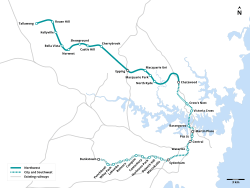Sydney Metro
Sydney Metro is a fully automated rapid transit system operating in Sydney, New South Wales. Currently consisting of one line that opened on 26 May 2019, it runs from Tallawong to Chatswood and consists of 13 stations and 36 km (22.4 mi) of twin tracks, mostly underground. Work is progressing to extend this line from Chatswood to Bankstown, running under Sydney Harbour and the Sydney central business district (City Centre) with a scheduled 2024 completion. When completed, this line will have 66 km (41.0 mi) of twin tracks and 31 stations. An additional 24 km (14.9 mi) is planned as part of the Sydney Metro West, and 23 km (14.3 mi) as part of the Western Sydney Airport line.
 | |||
.jpg) An Alstom Metropolis train arriving into Chatswood Station | |||
| Overview | |||
|---|---|---|---|
| Owner | Transport for NSW (through RailCorp) | ||
| Locale | Sydney | ||
| Transit type | Rapid transit | ||
| Number of lines |
| ||
| Number of stations |
| ||
| Daily ridership | 62,570[1] | ||
| Chief executive | Jon Lamonte[2] | ||
| Website | Sydney Metro | ||
| Operation | |||
| Began operation | 26 May 2019 | ||
| Operator(s) | Metro Trains Sydney | ||
| Character | Elevated, open-cut and underground | ||
| Number of vehicles | 22 six-cars Alstom Metropolis trains | ||
| Headway | 4 minutes (peak) 10 minutes (off-peak) | ||
| Technical | |||
| System length | |||
| Track gauge | 1,435 mm (4 ft 8 1⁄2 in) standard gauge | ||
| Electrification | 1500 V (DC) overhead line | ||
| Top speed | 100 km/h (62.1 mph) [5] | ||
| |||
The Sydney Metro West project has also been announced and will run from the Sydney City Centre (CBD) to Westmead, including 24 km (14.9 mi) of underground twin tracks and seven stations. Early design studies are underway to extend this line to the upcoming Western Sydney Airport, as well as additional lines between St Marys, Liverpool and Macarthur via the airport.
Sydney is the first and currently the only Australian city with a fully automated rapid transit metro system.[6][7] Plans and projects involving a high speed, rapid transit underground railway in Sydney date at least back to 2008,[8] although an initial proposal was raised as early as 2001.[9] Despite extensive plans for an underground network in the past, disputes over privatisation and funding had hampered government approval, delaying its inception. In spite of difficulties getting the project off the ground, government approval for what was initially known as the North West Rail Link, Sydney's first underground metro, was given in 2013. Route extensions and a name change to the Sydney Metro soon followed.[10]
The network is controlled by the Sydney Metro agency, under the umbrella of Transport for NSW. Services are operated by Metro Trains Sydney and integrated with the established Sydney Trains network.
History
Earlier proposals
The first proposals for a metro system in Sydney were put forward in 2001, when Co-ordinator-General of Rail Ron Christie released his "Long-term Strategic Plan for Rail" report, outlining long-term goals for the expansion of the rail network.[11] He suggested that a number of "metro" lines—operationally independent from the existing network—should be constructed past 2020 due to capacity constraints.[12] This was later dismissed by the New South Wales Government as only a "shopping list" of potential projects.[13]
The idea for a metro resurfaced in late 2007, when discussions about an underground 'Anzac Line' took place within the NSW Government. The line would have run from West Ryde in Sydney's north-west to Malabar in the south-east, but did not come to fruition.[14] In early 2008, following the shelving of various heavy rail expansion projects from the 2005 Metropolitan Rail Expansion Program (MREP), the Government officially announced the 37 km (23 mi) North West Metro.[15] Expected to cost $12 billion, it would have linked Rouse Hill in Sydney's north-west with the CBD, with construction starting in 2010 and finishing in 2017.[16]
The construction of the North West Metro was however dependent on the privatisation of the electricity network,[17] and after a change of the state's Premier in late 2008 it was cancelled due to budgetary concerns. Its replacement was the 9 km (5.6 mi), $4 billion CBD Metro, a shortened route running from Rozelle in the inner-west and into the CBD through to Central railway station.[18] Construction was scheduled to start in 2010, like its predecessor, but finish earlier in 2015. The CBD Metro was to have formed the "central spine" of a future metro network, with a planned West Metro extension to Westmead and Parramatta to be constructed soon after, subject to Federal funding.[19] Reception to the plans was mixed, with Opposition leader Barry O'Farrell accusing the Premier of "making it up as he goes along" after costings weren't released until after the press conference,[20] and criticism came from the Greens on the grounds that the route seemed designed to pass through marginal electoral seats.[21] The Government's initial submission to Infrastructure Australia for funding was rejected due to "a lack of integrated planning".[22] It was later revealed that the cost had jumped from $4 billion to $5.3 billion in six months,[23] and internal estimates showed that the metro would run at only 15% of its maximum capacity.[24]
The CBD Metro was cancelled in early 2010, after the Premier was deposed a few months before in 2009.[25][26] The Government had spent almost $410 million on the project.[27] The new Premier Kristina Keneally chose instead to focus on expansion of the existing heavy rail network, including the North West Rail Link and South West Rail Link.[28]
Revival

In mid-2012, the newly elected Coalition government announced Sydney's Rail Future and the NSW Transport Masterplan.[29] Under this proposal, the North West Rail Link would be built as a single-deck, privately operated metro connecting to a future second harbour crossing.[30] These plans received criticism on the basis that they might not have the capacity of existing double-deck trains,[31] and concerns over the inability of trains on the existing network to use the new crossing.[32]
In 2014, the Government announced the second harbour crossing under the name Sydney Rapid Transit, as part of the 'Rebuilding NSW' infrastructure plan funded through the sale of electricity infrastructure.[33][34] The new railway would cross Sydney Harbour, tunnel beneath the CBD, and join the Bankstown line which would be converted to metro standards.[35]
The system was officially renamed 'Sydney Metro' in June 2015 following the passage of power privatisation bills.[36] Opposing parties warned the government that the sale of the power infrastructure may not provide the capital needed.[37]
In July 2018, Sydney Metro was established as a statutory authority, tasked with leading the delivery of the metro system.[38] As of April 2019, Jon Lamonte is the Chief Executive of the agency.[2]
Operations
Sydney Metro services are operated by Metro Trains Sydney, a joint venture between MTR Corporation, John Holland Group, and UGL Rail, who will operate and maintain the network under a 15-year contract.[39] The network is fully automated to GoA4 level, and uses CBTC signalling throughout.[40]
Network
The Metro North West Line is currently the only line in the Sydney Metro network. It travels from Tallawong station to Chatswood station, with 13 stations along 36 km in total[41]. Since July 2019, services take 37 minutes from end to end, at a frequency of every 4 minutes during peak hours and every 10 minutes at all other times.[42][43] Prior to that, for the first few weeks after opening, the line operated one every 5 minutes during the peak hours until it was increased to every 4 minutes.[44][45]
Services began on 26 May 2019. For the first 6 months of operation, they were supplemented with trackwork style rail replacement buses for late night services from Sundays to Wednesdays.[46][47]
Rolling stock

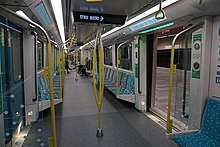
The network operates using 22 6-car Alstom Metropolis TS sets, which are fully automated electric multiple units. Each single-deck train features two dedicated areas for prams, luggage and bicycles. There are three doorways per side per carriage and no internal doors between the carriages.[48] In a 6-car configuration the trains have a seating capacity of 378 people, with a total capacity of 1,100.[49] Seating arrangements on the Alstom trains are longitudinal, in accordance with the style of most other metro trains.[50] The trains utilise Alstom's trademark Urbalis 400 Grade-of-Automation signalling system that ensures trains are capable of operating automatically at all times including door closing, obstacle detection and emergency situations.
Prior to the introduction of services, a full-scale model of the new train was built for use on public display, including at the annual Sydney Royal Easter Show.[51][52] It consists of the front carriage, including its distinctive nose. Members of the public are able to tour the inside of the mockup. It is approximately 75% of the length of the final design for the new carriages, having two doors instead of three.[53]
The trains were built at Alstom's rolling stock manufacturing facility in India,[54][55] with the first six-car Sydney Metro train arriving in Rouse Hill on 26 September 2017 to undergo testing.[56]
In February 2018, dynamic testing on the first of the trainsets began.[57] Testing was done on brakes, passenger information displays, lighting and door operation.[58]
Capacity
Stage 1 (Metro North West) operates with 6-car trains running on 4 minute headways. After the addition of the Stage 2 extension to Bankstown, the system will require at least 59 six-car trains to run every four minutes during peak periods. However the stations’ platforms will be configured to allow for future use of 8-car trains and the signalling system designed to allow for 2-minute headways, both of which are planned to be introduced once sufficient patronage demands it. Eight-car trains have a design capacity of 1,539 customers, and increasing the running frequency to ultimately 30 trains per hour (2-minute headway) would provide a maximum capacity of 46,170 passengers per hour per direction.[59] The line will run 21 or 22 hours.
Patronage
The following table lists patronage figures for the network during the corresponding financial year. Australia's financial years start on 1 July and end on 30 June. Major events that affected the number of journeys made or how patronage is measured are included as notes.
| Year | 2018-19 | 2019-20 | 2020-21 | 2021-22 | |
|---|---|---|---|---|---|
| Patronage (millions) |
2.0 [lower-alpha 1] |
||||
| References | [60] | ||||
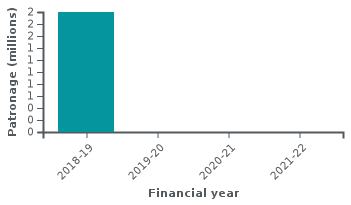 | |||||
- Sydney Metro opened in May 2019
Metro |
2 003 000 |
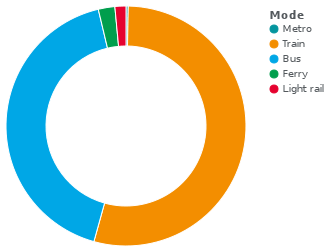 |
Train |
361 084 000 | |
Bus |
280 586 000 | |
Ferry |
14 850 000 | |
Light Rail |
9 918 000 |
Ticketing and costs
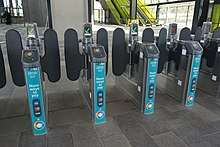
Sydney Metro uses the Opal card ticketing system. The fare system is fully integrated with the Sydney Trains network and the NSW TrainLink Intercity network - trips involving suburban, metro and intercity services are calculated as a single fare and there is no interchange penalty. Students who use the Sydney Metro network to get to and from schools can apply for a free School Opal card. Opal is also valid on bus, ferry, and light rail services but separate fares apply for these modes. The following table lists Opal fares for reusable smartcards and single trip tickets:[62]
| Metro or Train() as of 24 June 2019 | 0–10 km | 10–20 km | 20–35 km | 35–65 km | 65 km+ |
|---|---|---|---|---|---|
| Adult cards (peak) | $3.61 | $4.48 | $5.15 | $6.89 | $8.86 |
| Adult cards (off-peak) | $2.52 | $3.13 | $3.60 | $4.82 | $6.20 |
| Other cards (peak) | $1.80 | $2.24 | $2.57^ | $3.44^ | $4.43^ |
| Other cards (off-peak) | $1.26 | $1.56 | $1.79 | $2.20 | $3.10^ |
| Adult single trip | $4.50 | $5.60 | $6.40 | $8.40 | $10.80 |
| Child/Youth single trip | $2.20 | $2.80 | $3.20 | $4.20 | $5.40 |
^ = $2.50 for Senior/Pensioner cardholders
As there are no return or periodical options available, reusable Opal cards include a number of caps to reduce the cost for frequent travellers:
| Fare caps[63][64][65] () as of 17 February 2020 | Adult cards | Other concession cards | Senior/Pensioner cards |
|---|---|---|---|
| Daily Mon-Sat | $16.10 | $8 | $2.50 |
| Sunday | $2.80 | $2.80 | $2.50 |
| Weekly | $50 | $25 | $17.50 |
| Weekly Airport Station Access Fee |
$30.16 | $26.78 | $26.78 |
Projects
Sydney Metro Northwest

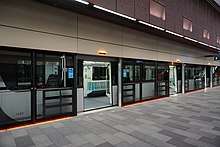
The first stage connects Sydney's north-western suburbs to Chatswood. It consists of 23 km (14 mi) of new track between Rouse Hill and Epping, which includes eight new stations. The 13 km (8.1 mi) Epping to Chatswood rail link has been converted to rapid transit standards and segregated from the existing Sydney Trains network.[66] Passengers are able to interchange with the existing system at both Epping and Chatswood. Construction on Sydney Metro Northwest began in late 2013.[67] The line opened on 26 May 2019.
In November 2016, Sydney Metro, in particular, the John Holland Group, Dragados and Transport for NSW, were awarded the 2016 NSW Premier's Award for Building Infrastructure for the 15 km twin-tunnels in Bella Vista and Epping, which are currently the longest tunnels constructed in Australia.[68] The completion of these tunnels in early 2016 marked the completion of the first stage of Sydney Metro Northwest. The NSW Premier's award recognises "infrastructure projects in the state that make a difference to the local community".[68]
Sydney Metro City & Southwest
The second stage will extend Sydney Metro Northwest, currently under construction, 30 km (19 mi) from Chatswood on the North Shore, to Central in the city central. The centrepiece of the project is a new twin-tunnel rail crossing under Sydney Harbour. Together with planned improvements to the Main Western line, the project is expected to increase capacity on the Sydney rail network by up to 60%, and allow for the movement of over 100,000 extra commuters across the network every hour.[69] The City & Southwest extension represents the first phase of the "southern sector conversion" envisaged in Sydney's Rail Future.[70]
Sydney Metro West
Sydney Metro West is a separate line between the Sydney CBD and Westmead. The line was announced as an official project on 14 November 2016,[71] with up to 12 stations being considered including station locations at Parramatta, Sydney Olympic Park, Five Dock, the Bays Precinct and the CBD. In March 2018, the government announced that an additional station would be built at Westmead, as well as one that connected to either of the existing stations at Concord West or North Strathfield.[72][73]
The 2019-2020 New South Wales state budget in June 2019 allocated funding of $6.4 billion over four years to the project, with construction to be fast-tracked to start in 2020.[74][75][76]
The government announced and confirmed seven station locations along the line.[77][78][79] Initial work is expected to start in 2020, with tunnelling to begin in 2022. The line is expected to open to the public by 2030.[80]
Western Sydney Airport line
In March 2018, the federal and state governments signed the Western Sydney City Deal and announced the development of stage 1 of the North-South Link as part of the deal.[81] Stage 1 of the Western Sydney Airport line will operate between St Marys and Badgerys Creek Aerotropolis via Western Sydney Airport. The line is expected to start construction in late 2020 and to be completed in 2026 in time for the opening of the airport.[82][83]
In the 2019-2020 federal budget in April 2019, the federal government announced a contribution of $3.5 billion to deliver stage 1 of the rail link.[84][85] This funding also includes $50 million towards the business case process for the North-South Rail Link and $61 million for the Elizabeth Drive overpass. In the 2019–2020 New South Wales state budget in June 2019, the state government announced an investment of $2.0 billion to commence the construction of stage 1 for the next 4 years.[86]
Potential extensions
Western Sydney routes
The Western Sydney Airport line is planned to be extended to connect to the Northwest line in Tallawong, and the Sydney Trains North Shore & Western and Cumberland lines at Schofields to the north, as well as the Airport & South Line at Macarthur to the south.[87] The West line would also be extended from Westmead to the Western Sydney Airport.[87]
Other extensions
The City & Southwest line is being planned to be extended from Bankstown to Liverpool.[87]
Other possible extensions considered have included a new line down through Randwick to Malabar, and a conversion of railway services to Miranda via Sydney Airport and Kogarah.[88]
To Hurstville
The second phase of the southern sector conversion would see two of the four tracks between Sydenham and Hurstville, part of the Sydney Trains Illawarra line, converted to rapid transit and added to the Sydney Metro network. This would increase rail capacity between Hurstville and the city by 10 trains per hour. Though a precise construction timeframe was not provided, the plan envisages all work being completed by 2031. The Hurstville conversion would add eight stations and 9 km (5.6 mi) to the metro network.[70] Developing plans for this extension has proven difficult, and the Sydney Morning Herald reported in February 2016 that the project may have been dropped.[89]
In media
A Seven News documentary on the early construction of part of the Sydney Metro aired on the Seven Network on 14 July 2016 titled World's Best Metro.[90]
Gallery
 Bella Vista Station
Bella Vista Station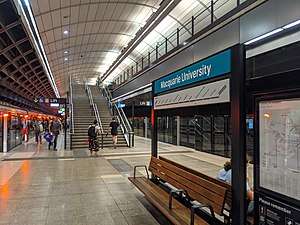 Macquarie University Station
Macquarie University Station Norwest Station entrance
Norwest Station entrance Interior doors
Interior doors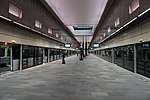

 Sydney Metro Northwest track
Sydney Metro Northwest track Train arriving into Kellyville Station
Train arriving into Kellyville Station Sydney Metro interior
Sydney Metro interior
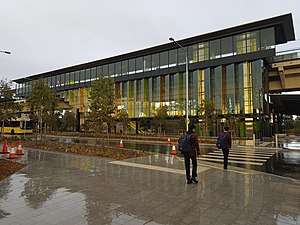
 Epping Station
Epping Station Opal Card machines at Cherrybrook Station
Opal Card machines at Cherrybrook Station Entrance to Rouse Hill Station
Entrance to Rouse Hill Station
References
- "Metro patronage". Transport for NSW. Retrieved 3 November 2019.
- New Chief Executive appointed to Sydney Metro Transport for NSW 27 September 2018
- "Sydney Metro". urbanrail.net. Retrieved 16 September 2019.
- "About Sydney Metro". Sydney Metro. Retrieved 27 May 2019.
- "Metro train passes 100km/h speed test". Sydney Metro. 13 August 2018. Retrieved 27 May 2019.
- "Sydney Metro: Info". sydneymetro.info. 13 July 2015.
- "Sydney Metro an Australian first". mondaq.com. 8 December 2009. Retrieved 13 July 2015.
- "Don't worry about debt, Sydney needs this metro". The Sydney Morning Herald. 29 September 2008. Retrieved 13 July 2015.
- "Long Term Strategic Plan for Rail" (PDF). catalyst.com.au. June 2001. Retrieved 13 June 2015.
- "NSW tests the market over Sydney Metro construction". The Australian. 23 June 2015. Retrieved 13 July 2015.
- Ron, Christie (June 2001). "1. Introduction". Long-Term Strategic Plan for Rail (Report).
- Ron, Christie (June 2001). "5. Beyond 2010: Overcoming the critical inner city constraint and implementing a longer term vision". Long-Term Strategic Plan for Rail (Report).
- "Christie Report". Action for Public Transport. Retrieved 14 June 2015.
- Besser, Linton (14 September 2007). "New east-west line may cut congestion". Sydney Morning Herald. Fairfax Media. Retrieved 14 June 2015.
- Besser, Linton (26 February 2008). "Bye heavy rail, now for a north-west metro". Sydney Morning Herald. Fairfax Media. Retrieved 14 June 2015.
- Iemma, Morris. "Premier Iemma unveils Sydney's first Euro-style metro rail project" (PDF). NSW Government. Archived from the original (PDF) on 20 July 2008. Retrieved 14 June 2015.
- Gittins, Ross (17 March 2008). "Iemma's reasons for privatising electricity". The Sydney Morning Herald. Fairfax Media. Retrieved 14 June 2015.
- Benson, Simon (31 October 2008). "Northwest Metro rail link officially shelved". The Daily Telegraph. News Corp. Retrieved 14 June 2015.
- "Metro: The future of Sydney's transport" (PDF). NSW Government. 30 June 2009. Archived from the original (PDF) on 4 July 2009.
- "Metro-sexual Rees flags new rail link". The Daily Telegraph. News Corp. 24 October 2008.
- Clennel, Andrew; Besser, Linton (21 April 2009). "CBD Metro cost jumps $1.3b in six months". The Sydney Morning Herald. Fairfax Media. Retrieved 14 June 2015.
- Smith, Alexandra (6 February 2009). "'Inadequate' submission puts NSW down the list". The Sydney Morning Herald. Fairfax Media.
- Ralston, Nick (24 October 2008). "Rees reveals new Sydney Metro plan". The Sydney Morning Herald. Fairfax Media. Retrieved 14 June 2015.
- Besser, Linton (4 May 2009). "CBD Metro will run almost empty". The Sydney Morning Herald. Fairfax Media.
- "Keneally rolls Rees and takes top job". ABC News. AAP. 4 December 2009.
- "Keneally scraps CBD Metro plans". ABC News. ABC/AAP. 22 February 2010.
- Haynes, Rhys (3 December 2010). "Metro rail plan was 'wasteful'". The Daily Telegraph. News Corp.
- Newman, Peter (23 February 2010). "An end to Sydney's transport lost years?". The Sydney Morning Herald. Fairfax Media.
- "Sydney's Rail Future" (PDF). Transport for NSW. June 2012.
- Saulwick, Jacob (20 June 2012). "Sydney transport shake-up: plan for single deck metro-style trains and second harbour crossing". The Sydney Morning Herald. Fairfax Media.
- Saulwick, Jacob (23 September 2013). "Secret report casts doubt on train plan". The Sydney Morning Herald. Fairfax Media.
- Saulwick, Jacob (4 July 2012). "Tunnel too small could make rail link a bridge too far". Drive. Fairfax Media.
- "Transforming Sydney: Sydney Rapid Transit" (PDF). Transport for NSW. November 2014.
- "Rebuilding NSW". NSW Government. November 2014. Retrieved 15 June 2015.
- Geralthy, Sarah; Liz, Foschia (11 June 2014). "Sydney rapid transit rail build could begin in three years, NSW Transport Minister Gladys Berejiklian says". ABC News.
- "Funding secured: Sydney Metro to be a reality". Transport for NSW. 4 June 2015. Archived from the original on 23 June 2015.
- Gerathy, Sarah (4 June 2015). "Power vote means Sydney Harbour rail crossing is less than a decade away: NSW Premier Mike Baird". ABC News.
- "New transport era as Sydney Metro authority comes into effect". Transport for NSW. 5 July 2018. Retrieved 27 May 2019.
- "About Us". Metro Trains Sydney. Retrieved 29 May 2019.
- Fried, Oliver. "Australia's First Fully Automated Metro Opportunities & Solutions" (PDF). ARA. Retrieved 29 May 2019.
- "Sydney Metro - Information, Route Map, Fare & Timings". The Metro Rail Guy. Retrieved 30 March 2020.
- "M: Metro North West line timetable". Transport for NSW.
- "Metro North West Line timetable - 1 July 2019". Transport for NSW. Archived (PDF) from the original on 18 June 2019. Retrieved 27 August 2019.
- "Metro North West Line timetable - 27 May 2019" (PDF). Transport for NSW. Archived from the original on 8 May 2019. Retrieved 25 August 2019.
- "North West opening date announced". Sydney Metro. 5 May 2019. Archived from the original on 5 May 2019. Retrieved 6 May 2019.
- "NW1 Timetable - May 2019" (PDF). Transport Info NSW. Archived (PDF) from the original on 5 May 2019. Retrieved 10 May 2019.
- "NW2 Timetable - May 2019" (PDF). Transport Info NSW. Archived (PDF) from the original on 5 May 2019. Retrieved 10 May 2019.
- "Case study: North West Rail Link, Sydney, Australia". Alstom. Archived from the original on 4 March 2016. Retrieved 14 October 2015.
- O'Rourke, Jim (5 November 2015). "Sydney Metro Northwest: Transport minister unveils life-size model of Metropolis carriage". The Daily Telegraph. Retrieved 7 November 2015.
- "Alstom's first 'Make in India' Metro inaugurated in Kochi". raillynews.com. 19 June 2017. Retrieved 21 January 2018.
- "Check out the Sydney Metro train". Retrieved 29 July 2017.
- "Transport for NSW Sydney Metro Marquee at the Sydney Royal Easter Show 2016 - Proj-X Design". www.proj-x.com.au. Retrieved 29 July 2017.
- "First glimpse of new Metro train | Sydney Metro". www.sydneymetro.info. Retrieved 30 July 2017.
- "Sydney Metro Receives First Indian Built Alstom Train". The Metro Rail Guy. 28 September 2017. Retrieved 30 March 2020.
- "First metro trains arrive for new $8.3 billion line to Sydney's north west". Sydney Morning Herald. 26 September 2017. Retrieved 20 January 2018.
- "First Sydney Metro train arrives". NSW Government. 26 September 2017. Retrieved 27 September 2017.
- UK, DVV Media. "Sydney metro train on test". Metro Report. Retrieved 11 February 2018.
- "First Metro Train Testing | Sydney Metro". www.sydneymetro.info. Retrieved 11 February 2018.
- "SYDNEY METRO CITY & SOUTHWEST |page 51 BUSINESS CASE SUMMARY" (PDF). Transport for NSW. Retrieved 28 February 2017.
- "Metro Patronage Monthly Comparison". Transport for NSW. Retrieved 1 March 2020.
- See Transport for NSW patronage in Sydney by mode for sources
- "Opal fares". transportnsw.info. Transport for NSW. Retrieved 22 June 2019.
- "Opal benefits". opal.com.au. Transport for NSW. Retrieved 2 July 2018.
- "Getting to and from Sydney Airport". transportnsw.info. Transport for NSW. Retrieved 17 February 2020.
- Opal fare changes from 24 June Transport for NSW 21 June 2019
- "Green light for the North West Rail Link" (PDF). Transport for NSW. June 2013. Retrieved 7 November 2015.
- "Construction ramps up as Showground Station site is cleared". Transport for NSW. 23 October 2013. Archived from the original on 7 November 2015. Retrieved 7 November 2015.
- "Sydney Metro receives awards for excellence". Trenchless Australasia. 28 November 2016. Retrieved 28 November 2016.
- Walker, Ian. "Construction begins on second Sydney Harbour rail crossing". The Daily Telegraph. Retrieved 23 April 2015.
- Transport for New South Wales (June 2012). Sydney's rail future: modernising Sydney's trains (PDF).
- "Sydney Metro West: a new railway, more trains for Western Sydney". Transport for NSW. 14 November 2016.
- "Further Sydney Metro West stations revealed". Sydney Metro. Transport for NSW. 23 March 2018. Retrieved 23 March 2018.
- O'Sullivan, Matt (23 March 2018). "The Sydney suburbs on list of station sites for new metro line". The Sydney Morning Herald. Retrieved 23 March 2018.
- "Government getting it done on Metro West". Transport for NSW. 18 June 2019. Retrieved 19 June 2019.
- "$3.4bn added to fast-forward Sydney metro west". Global Construction Review (GCR). 18 June 2019. Retrieved 19 June 2019.
- "Infrastructure Statement 2019-2020 Budget Paper No.2" (PDF). NSW Government. Retrieved 12 September 2019.
- "Construction of the Western Sydney Metro to start next year". Transport for NSW. 21 October 2019. Archived from the original on 21 October 2019. Retrieved 21 October 2019.
- "NSW Government confirms seven new Sydney train stations for Metro West project". ABC News. 21 October 2019. Retrieved 21 October 2019.
- "Sydney Metro West stations confirmed" (PDF). Sydney Metro. NSW Government. 21 October 2019. Archived (PDF) from the original on 21 October 2019. Retrieved 21 October 2019.
- "NSW Government confirms seven new Sydney train stations for Metro West project". ABC News. 21 October 2019. Retrieved 21 October 2019.
- "Western Sydney City Deal to deliver rail, investment and jobs". Transport for NSW. 4 March 2018. Retrieved 6 March 2018.
- "Western Sydney City Deal - Connectivity". Department of Infrastructure, Regional Development and Cities. Retrieved 16 March 2018.
- "Scott Morrison announces construction on Western Sydney Airport metro line to start this year". 7News. 1 June 2020. Retrieved 1 June 2020.
- "Western Sydney North South Rail Link Package". Department of Infrastructure, Transport, Cities and Regional Development. Retrieved 12 September 2019.
- "Federal Budget 2019: Western Sydney Airport rail line, North-South Rail Link included in NSW $7.3b infrastructure boost". Sydney Morning Herald. 2 April 2019. Retrieved 12 September 2019.
- "Infrastructure Statement 2019-2020 Budget Paper No.2" (PDF). NSW Government. Retrieved 12 September 2019.
- "Sydney Metro Corporate Plan" (PDF).
- O'Sullivan, Matt (3 February 2019). "New metro rail line to Sydney's south-east in the pipeline". The Sydney Morning Herald. Retrieved 2 June 2020.
- O'Sullivan, Matt; Saulwick, Jacob (3 February 2016). "Plan to extend Sydney metro line south hits growing list of hurdles". The Sydney Morning Herald.
- "AIRDATE: Seven News Presents: Worlds Best Metro". Decider TV. 11 July 2016. Retrieved 15 July 2016.
External links
| Wikimedia Commons has media related to Sydney Metro. |
